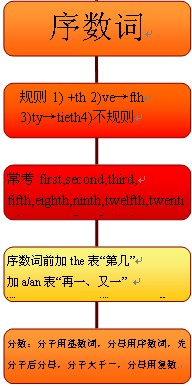本试题 “.III. Reading Comprehension Section ADirections: For each blank in the following passage there are four words or phrases marked A, B, C and D. Fill...” 主要考查您对序数词
等考点的理解。关于这些考点您可以点击下面的选项卡查看详细档案。
- 序数词
序数词的概念:
表示顺序的数称为序数词。如:first, second, third, fourth。
序数词的构成与用法:
1、序数词的构成:
①一般来说,是由相应的基数词加词尾th构成。
例:four+th→fourth
six+th→sixth
seven+th→seventh
ten+th→tenth
②下面这些基数词在变为序数词时,有特殊的变化。
例:one→first
two→second
three→third
five→fifth
eight→eighth
nine→ninth
twelve→twelfth
③十位整数序数词的构成方法是将基数词的词y变成i,然后再加eth。
例:twenty→twentieth
thirty→thirtieth
forty→fortieth
ninety→ninetieth
④两位或两位以上的基数词变成序数词时,仅将个位数变成序数词。
例:twenty-one→twenty-first
thirty-five→thirty-fifth
a hundred and fifty-three→a hundred and fifty-third
2、序数词的用法:
①序数词在使用时,一般加上定冠词。
例:the first book
the second floor
the third day
the fourth week.
②序数词在多数情况下都用作定语,有的也可以作表语、主语和宾语。
例:The may1st is Labour Day. 五月一日是劳动节。
My room is on the second floor. 我的房间在二楼。
The first is larger than the secon.(主语)第一个比第二个大。
Read the book from the first.(宾语)从开头读这本书。
You'll be the sixth to write.(表语)你将是第六个写的。
③序数词的前面可以加上不定冠词,用来表示“再一”,“又一”的意思。
例:You may have a third try. 你可以第三次尝试。
序数词知识体系:

约数的表达方法:
用tens/dozens/scores/hundreds/thousands/millions of 表示“几十、几百、上千、成千上万”等。
如:The boy bought dozens of pencils.
Thousands of people died in the earthquake.
注意: (A):dozen, score, hundred, thousand, million等表示确切数量时,不用复数。
如:five dozen (of) eggs 五打鸡蛋
hree hundred people 三百个人
分数词的构成和用法:
1)分数词构成法:
分数词(FractionalNumerals)由基数词和序数词构成,基数词代表分子,序数词代表分母。除了分子为1的情况下,序数词都要用复数形式:
如:1/4:one-fourth
5/9:five-ninths
2/3:two-thirds
17/5:three and two-fifths
7/12:seven-twelfths
379/8:forty-seven and three-eighths
此外还有下面表示法:
如:1/2:a(one) half
1/4:a(one) quarter
3/4:three-quarters
9/4:two and a quarter
3/2:one and half
31/4:seven and three quarters
与“.III. Reading Comprehension Section ADirections: For each...”考查相似的试题有:
- 第II 卷(共50分)第二节短文改错(共10小题;每小题1分,满分10分)At first I was not quite willing to sit down and watc...
- (2013·高考新课标全国卷Ⅱ)Would you like to________with us to the film tonight?A.come alongB.come offC.come acrossD...
- 阅读下面短文,根据以下提示:1)汉语提示,2)首字母提示,3)语境提示,在每个空格内填入一个适当的英语单词,并将该词完整...
- 任务型阅读(共10题;每小题1分,满分10分)请认真阅读下列短文,并根据所读内容在文章后表格中的空格里填入最恰当的单词。注意...
- One evening I was resting in a cafe. I wore a pair of newly bought white leather shoes, 小题1: were rather expensive....
- 根据短文内容,从A-F选项中选出能概括每段主题的最佳选项,并在答题纸上将该选项标号涂黑。选项中有一项是多余项。A. Be your...
- In this article I'd like to tell you how to behave better in an IELTS oral English test. Everyone will make necessary...
- He is driving a truck _______ of bananas when he came off the road at the bend and fell three hundred metres down the...
- 第一节 完形填空(共10小题;每小题2分,满分20分)阅读下面短文,掌握其大意,然后从21~30各题所给的A、B、C和D项中,选出最...
- 第二卷(主观题,共35分)第四部分:写作(共二节,满分35分)第一节 任务型读写(共10小题;每小题1分,满分10分)请认真阅...